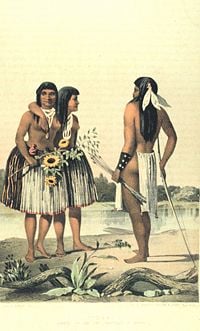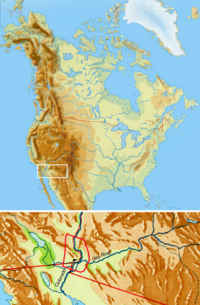Yuman
The Quechan (also Yuma, Yuman, Kwtsan, Kwtsaan) are a Native American tribe who live on the Fort Yuma Reservation on the lower Colorado River in Arizona just north of the border with Mexico.
The Quechan are one of the Yuman tribes. They should not be confused with the Quechuas, which is the term used for several ethnic groups that use a Quechua language in South America, particularly in Peru, Ecuador, Bolivia, Chile, and Argentina.
Yuman is derived from the old name for the tribe, Yuma. The reservation is a part of their traditional lands. Established in 1884, the Fort Yuma Indian Reservation has a land area of 178.197 km² (68.802 sq mi) in southeastern Imperial County, California, and western Yuma County, Arizona, near the city of Yuma, Arizona.
The Yuman people are a group of Native American ethnic groups of the Yuman language family. The historic Yuman-speaking peoples in this region were skilled warriors and active traders, maintaining exchange networks with the Pima in southern Arizona and with the Pacific coast.
The term Patayan is used by archaeologists to describe the prehistoric Native American cultures that inhabited parts of modern day Arizona, California and Baja California, including areas near the Colorado River Valley, the nearby uplands, and north to the vicinity of the Grand Canyon. These prehistoric people may have been ancestoral to the Yuman. They practiced floodplain agriculture where possible, but relied heavily on hunting and gathering.
History
The first important contact of the Quechan with Europeans was with the Spanish explorer Juan Bautista de Anza and his party in the winter of 1774. Relations were friendly and on Anza's return from his second trip to Alta California in 1776 the chief of the tribe and three others journeyed to Mexico City to petition the Viceroy of New Spain for the establishment of a mission. The chief, Palma and his 3 companions were baptized there on February 13, 1777. Palma was given the name Salvador Carlos Antonio.
Spanish settlement among the Quechan did not go as well as hoped and the tribe rebelled on July 17, 1781 and killed 4 priests and 30 soldiers. The Spanish mission settlements of San Pedro y San Pablo de Bicuñer and Puerto de Purísima Concepción were also decimated. The tribe was punished militarily the following year.
The United States engaged the Yuma Indians in warfare during the Yuma Expedition, which was one of many Indian Wars that took place before the American Civil War.
Population
Estimates for the pre-contact populations of most native groups in California have varied substantially (see population of Native California). Alfred L. Kroeber (1925:883) put the 1770 population of the Quechan at 2,500. Jack D. Forbes (1965:341-343) compiled historical estimates and suggested that before they were first contacted the Quechan had numbered 4,000 or a few more.
Kroeber estimated the population of the Quechan in 1910 as 750. By 1950, there were reported to be just under 1,000 Quechan living on the reservation and another 1,100+ off it (Forbes 1965:343). The 2000 census reported a resident population of 2,376 persons on the Fort Yuma Indian Reservation, only 56.8 percent of whom were of solely Native American heritage, and more than 27 percent of whom were white.
Yuma traditional narratives
Quechan traditional narratives include myths, legends, tales, and oral histories preserved by the Quechan (Yuma) people of the lower Colorado River area of southeastern California, southwestern Arizona, and northeastern Baja California.
The Southern California Creation Myth is particularly prominent in Quechan oral literature. This and other narrative elements are shared with the other Yuman-speaking peoples of southern California, western Arizona, and northern Baja California, as well as with their Uto-Aztecan-speaking neighbors.
ReferencesISBN links support NWE through referral fees
- Curtis, Edward S. 1907-1930. The North American Indian. 20 vols. Plimpton Press, Norwood, Massachusetts. (Creation myth, vol. 2, pp. 73-77.)
- DuBois, Constance Goddard. 1908. "Ceremonies and Traditions of the Diegueño Indians." Journal of American Folklore 21:228-236." (Brief version of Quechan creation myth.)
- Emerson, Lee, and A. M. Halpern. 1978. "Coyote and Quail (Yuma-Quechan)." In Coyote Stories, edited by William Bright, pp. 124-136. International Journal of American Linguistics Native American Texts Series No. 1. University of Chicago Press. (Recorded in 1976.)
- Erdoes, Richard, and Alfonso Ortiz. 1984. American Indian Myths and Legends. Pantheon Books, New York. (Retelling of a narrative partly from Curtis 1909, pp. 77-82.)
- Forde, C. Daryll. 1931. "Ethnography of the Yuma Indians." University of California Publications in American Archaeology and Ethnology 28:83-277. Berkeley. (Creation myths with comparative discussion, pp. 176-179, 214-221.)
- Gifford, Edward Winslow, and Gwendoline Harris Block. 1930. California Indian Nights. Arthur H. Clark, Glendale, California. (Previously published version of Creation myth, pp. 107-112.)
- Halpern, Abraham M. 1976. "Kukumat Becomes Sick—A Yuman Text." In Yuman Texts, edited by Margaret Langdon, pp. 5-25. International Journal of American Linguistics Native American Texts Series No. 1(3). University of Chicago Press.
- Harrington, John Peabody. 1908. "A Yuma Account of Origins." Journal of American Folklore 21:324-348. (Brief note on creation myth recorded in 1929, p. 15.)
- Hinton, Leanne, and Lucille J. Watahomigie. 1984. Spirit Mountain: An Anthology of Yuman Story and Song. University of Arizona Press, Tucson. (Includes Quechan narratives collected by Abraham Halpern, pp. 298-313.)
- Luthin, Herbert W. 2002. Surviving through the Days: A California Indian Reader. University of California Press, Berkeley. (Excerpt from Harrington 1908, pp. 461-489.)
- Halpern, Abraham M. 1997. Kar'uk: Native Accounts of the Quechan Mourning Ceremony. University of California Publications in Linguistics 128. University of California Press.
- Waldman, Carl. 2006. Encyclopedia of Native American Tribes. New York, NY: Checkmark Books. ISBN 978-0816062744.
- Forbes, Jack D. 1965. Warriors of the Colorado: The Yumas of the Quechan Nation and Their Neighbors. University of Oklahoma Press, Norman.
- Kroeber, A. L. 1925. Handbook of the Indians of California. Bureau of American Ethnology Bulletin No. 78. Washington, D.C.
- Yuma Reservation, California/Arizona United States Census Bureau
- Spier, Leslie. [1933] 1978. Yuman Tribes of the Gila River. New York, NY: Dover Publications. ISBN 0486236110
- Bee, Robert L. Bee, and Frank W. Porter. 1989. The Yuma (Indians of North America). Chelsea House Publications. ISBN 1555467377
- Bee, Robert L. (1983). "Quechan." In Handbook of North American Indians. Vol. 10, Southwest, Alfonso Ortiz (ed.), 86-98. Washington, DC: Smithsonian Institution.
- Garrigues, Lisa. 2008. Quechan elders take fight against casino resort to Washington Indian Country Today, August 12, 2008. Retrieved September 7, 2008.
- Fenger, Darin. 2007. Quechan filmmaker says he's grateful for blessings News From Indian Country, 5-27-07. Retrieved September 7, 2008.
External links
- Fort Yuma-Quechan Tribe Inter-Tribal Council of Arizona
- Curtis, Edward S. 1908. The North American Indian
- DuBois, Constance Goddard. 1908. "Ceremonies and Traditions of the Diegueño Indians" Journal of American Folk-lore XXI(82): 228-236.
- The River Yuman People Native American Desert Peoples, DesertUSA.
Credits
New World Encyclopedia writers and editors rewrote and completed the Wikipedia article in accordance with New World Encyclopedia standards. This article abides by terms of the Creative Commons CC-by-sa 3.0 License (CC-by-sa), which may be used and disseminated with proper attribution. Credit is due under the terms of this license that can reference both the New World Encyclopedia contributors and the selfless volunteer contributors of the Wikimedia Foundation. To cite this article click here for a list of acceptable citing formats.The history of earlier contributions by wikipedians is accessible to researchers here:
The history of this article since it was imported to New World Encyclopedia:
Note: Some restrictions may apply to use of individual images which are separately licensed.

